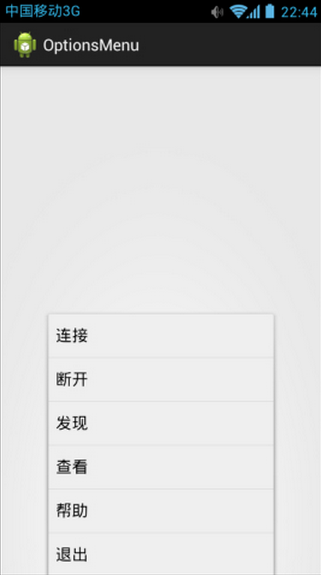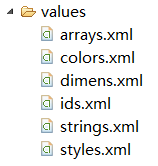Android资源文件中各种XML的作用与解释
2016-11-18 11:07
471 查看
转自:http://blog.csdn.net/xiaoli100861/article/details/51766906#t2 (高速蜗牛的博客)
众所周知,XML是一种可扩展标记语言,它被用来传输和存储数据。在Android中也会随处可见XML文件,包括一个android项目不可缺少的AndroidManifest.xml清单文件,res资源文件目录下的anim/drawable/layout/menu/values中等,目录截图如下。其中清单文件中内容最多最复杂,完全可以在其他文章中再来讲解,所以本文主要讲解res目录下的XML的作用与内容。

代码:
[html]
view plain
copy


<?xml version="1.0" encoding="utf-8"?>
<animation-list xmlns:android="http://schemas.android.com/apk/res/android"
android:oneshot="false">
<item android:drawable="@drawable/a_01" android:duration="50"/>
<item android:drawable="@drawable/a_02" android:duration="50"/>
<item android:drawable="@drawable/a_03" android:duration="50"/>
<item android:drawable="@drawable/a_04" android:duration="50"/>
<item android:drawable="@drawable/a_05" android:duration="50"/>
<item android:drawable="@drawable/a_06" android:duration="50"/>
</animation-list>
<animation-list>元素是必须的,并且必须要作为根元素,可以包含一或多个元素;android:onshot如果定义为true的话,此动画只会执行一次,如果为false则一直循环;元素代表一帧动画, android:drawable指定此帧动画所对应的图片资源;android:druation代表此帧持续的时间, 整数,单位为毫秒。
代码:
① 旋转
[html]
view plain
copy


<?xml version="1.0" encoding="utf-8"?>
<set xmlns:android="http://schemas.android.com/apk/res/android"
android:interpolator="@android:anim/accelerate_interpolator">
<!--fromDegrees:开始的角度
toDegrees: 结束的角度, +表示是正的
pivotX: 用于设置旋转时的x轴坐标 例 当值为"50",表示使用绝对位置定位 当值为"50%",表示使用相对于控件本身定位 当值为"50%p",表示使用相对于控件的父控件定位
pivotY: 用于设置旋转时的y轴坐标 -->
<rotate
android:fromDegrees="0"
android:toDegrees="+360"
android:pivotX="50%"
android:pivotY="50%"
android:duration="1000"/>
</set>
② 平移
[html]
view plain
copy


<?xml version="1.0" encoding="utf-8"?>
<set xmlns:android="http://schemas.android.com/apk/res/android"
android:interpolator="@android:anim/accelerate_interpolator">
<!--
始x轴坐标
止x轴坐标
始y轴坐标
止y轴坐标缩放
-->
<translate
android:fromXDelta="0%"
android:toXDelta="100%"
android:fromYDelta="0%"
android:toYDelta="100%"
android:duration="2000"/>
</set>
③ 缩放
[html]
view plain
copy


<?xml version="1.0" encoding="utf-8"?>
<set xmlns:android="http://schemas.android.com/apk/res/android"
android:interpolator="@android:anim/accelerate_interpolator">
<!--
起始x轴坐标
止x轴坐标
始y轴坐标
止y轴坐标
x轴的坐标
y轴的坐标
-->
<scale
android:fromXScale="1.0"
android:toXScale="0.0"
android:fromYScale="1.0"
android:toYScale="0.0"
android:pivotX="50%"
android:pivotY="50%"
android:duration="1000"/>
</set>
④ 透明度
[html]
view plain
copy


<?xml version="1.0" encoding="utf-8"?>
<set xmlns:android="http://schemas.android.com/apk/res/android"
android:interpolator="@android:anim/accelerate_interpolator">
<!-- fromAlpha和toAlpha是起始透明度和结束时透明度 -->
<alpha
android:fromAlpha="1.0"
android:toAlpha="0.0"
android:startOffset="500"
android:duration="500"/>
</set>
代码:
[html]
view plain
copy


<?xml version="1.0" encoding="utf-8"?>
<shape xmlns:android="http://schemas.android.com/apk/res/android"
android:shape=["rectangle"|"oval"|"line"|"ring"] >
<!-- 圆角 -->
<corners
android:radius="integer"
android:topLeftRadius="integer"
android:topRightRadius="integer"
android:bottomLeftRadius="integer"
android:bottomRightRadius="integer" />
<!-- 渐变 -->
<gradient
android:angle="integer"
android:centerX="integer"
android:centerY="integer"
android:centerColor="integer"
android:endColor="color"
android:gradientRadius="integer"
android:startColor="color"
android:type=["linear"|"radial"|"sweep"]
android:useLevel=["true"|"false"] />
<padding
android:left="integer"
android:top="integer"
android:right="integer"
android:bottom="integer" />
<size
android:width="integer"
android:height="integer" />
<solid
android:color="color" />
<!-- 描边 -->
<stroke
android:width="integer"
android:color="color"
android:dashWidth="integer"
android:dashGap="integer" />
</shape>
代码:
[html]
view plain
copy


<?xml version="1.0" encoding="utf-8" ?>
<selector xmlns:android="http://schemas.android.com/apk/res/android">
<!-- 默认时的背景图片-->
<item android:drawable="@drawable/a_01" />
<!-- 没有焦点时的背景图片 -->
<item android:state_window_focused="false"
android:drawable="@drawable/a_01" />
<!-- 非触摸模式下获得焦点并单击时的背景图片 -->
<item android:state_focused="true"
android:state_pressed="true"
android:drawable="@drawable/a_02" />
<!-- 触摸模式下单击时的背景图片-->
<item android:state_focused="false"
android:state_pressed="true"
android:drawable="@drawable/a_03" />
<!--选中时的图片背景-->
<item android:state_selected="true"
android:drawable="@drawable/a_04" />
<!--获得焦点时的图片背景-->
<item android:state_focused="true"
android:drawable="@drawable/a_05" />
</selector>
代码:
[html]
view plain
copy


<?xml version="1.0" encoding="utf-8"?>
<menu xmlns:android="http://schemas.android.com/apk/res/android">
<item android:id="@+id/connect"
android:orderInCategory="100"
android:showAsAction="never"
android:icon="@android:drawable/ic_menu_send"
android:title="连接" />
<item android:id="@+id/disconnect"
android:orderInCategory="100"
android:showAsAction="never"
android:icon="@android:drawable/ic_menu_close_clear_cancel"
android:title="断开" />
<item android:id="@+id/search"
android:orderInCategory="100"
android:showAsAction="never"
android:icon="@android:drawable/ic_menu_search"
android:title="发现" />
<item android:id="@+id/view"
android:orderInCategory="100"
android:showAsAction="never"
android:icon="@android:drawable/ic_menu_view"
android:title="查看" />
<item android:id="@+id/help"
android:orderInCategory="100"
android:showAsAction="never"
android:icon="@android:drawable/ic_menu_help"
android:title="帮助" />
<item android:id="@+id/exit"
android:orderInCategory="100"
android:showAsAction="never"
android:icon="@android:drawable/ic_menu_revert"
android:title="退出" />
</menu>
效果:


代码:
[html]
view plain
copy


<?xml version="1.0" encoding="utf-8"?>
<resources>
<string-array name="select_items">
<item>one</item>
<item>two</item>
<item>three</item>
<item>four</item>
</string-array>
</resources>
使用:
[java]
view plain
copy


String[] items = getResources().getStringArray(R.array.select_items);
items数组中的数据就是arrays.xml文件中对应资源id R.array.selec_items中的数据。
代码:
[html]
view plain
copy


<?xml version="1.0" encoding="utf-8"?>
<resources>
<color name="red">#ff00000</color>
<color name="black">#000000</color>
<color name="white">#ffffff</color>
</resources>
使用:
[java]
view plain
copy


btn.setBackgroundColor(getResources().getColor(R.color.red));
代码:
[html]
view plain
copy


<resources>
<!-- 控件的大小 -->
<dimen name="title_width">200dp</dimen>
<dimen name="title_height">50dp</dimen>
<!-- 字体的大小 -->
<dimen name="info_size">20sp</dimen>
<dimen name="tip_size">16sp</dimen>
lt;/resources>
使用:
[html]
view plain
copy


<TextView
android:layout_width="@dimen/title_width"
android:layout_height="@dimen/title_height"
android:textSize="@dimen/info_size"/>
代码:
[html]
view plain
copy


<?xml version="1.0" encoding="utf-8"?>
<resources>
<item name="send" type="id"/>
<item name="public" type="id"/>
</resources>
使用:
[html]
view plain
copy


<TextView
android:id="@id/send"
android:layout_width="@dimen/title_width"
android:layout_height="@dimen/title_height"
android:textSize="@dimen/info_size"/>
代码:
[html]
view plain
copy


<?xml version="1.0" encoding="utf-8"?>
<resources>
<string name="app_name">TestDemo</string>
<string name="action_add">添加</string>
<string name="action_del">删除</string>
<string name="action_settings">设置</string>
<string name="action_about">关于</string>
<string name="action_suggest">建议反馈</string>
</resources>
使用:
[html]
view plain
copy


<TextView
android:id="@id/send"
android:layout_width="@dimen/title_width"
android:layout_height="@dimen/title_height"
android:textSize="@dimen/info_size"
android:text="@string/action_add"/>
代码:
[html]
view plain
copy


<resources>
<style name="myDialog" parent="@android:style/Theme.Dialog">
<item name="android:windowBackground">@color/transparent</item>
<!-- 设置dialog背景 -->
<item name="android:windowNoTitle">true</item>
<!-- 无标题 -->
<item name="android:windowIsFloating">true</item>
</style>
</resources>

众所周知,XML是一种可扩展标记语言,它被用来传输和存储数据。在Android中也会随处可见XML文件,包括一个android项目不可缺少的AndroidManifest.xml清单文件,res资源文件目录下的anim/drawable/layout/menu/values中等,目录截图如下。其中清单文件中内容最多最复杂,完全可以在其他文章中再来讲解,所以本文主要讲解res目录下的XML的作用与内容。

一、anim目录
anim目录下的xml主要是用于android中的动画,包括Frame animation(逐帧动画)与Tween animation(补间动画 )。1.逐帧动画
逐帧动画是一系列图片按照一定的顺序展示的过程,和放电影的机制很相似。可以理解成GIF,一帧一帧的显示图片。代码:
[html]
view plain
copy

<?xml version="1.0" encoding="utf-8"?>
<animation-list xmlns:android="http://schemas.android.com/apk/res/android"
android:oneshot="false">
<item android:drawable="@drawable/a_01" android:duration="50"/>
<item android:drawable="@drawable/a_02" android:duration="50"/>
<item android:drawable="@drawable/a_03" android:duration="50"/>
<item android:drawable="@drawable/a_04" android:duration="50"/>
<item android:drawable="@drawable/a_05" android:duration="50"/>
<item android:drawable="@drawable/a_06" android:duration="50"/>
</animation-list>
<animation-list>元素是必须的,并且必须要作为根元素,可以包含一或多个元素;android:onshot如果定义为true的话,此动画只会执行一次,如果为false则一直循环;元素代表一帧动画, android:drawable指定此帧动画所对应的图片资源;android:druation代表此帧持续的时间, 整数,单位为毫秒。
2. 补间动画
补间动画包括旋转、 平移、缩放和透明度等效果。代码:
① 旋转
[html]
view plain
copy

<?xml version="1.0" encoding="utf-8"?>
<set xmlns:android="http://schemas.android.com/apk/res/android"
android:interpolator="@android:anim/accelerate_interpolator">
<!--fromDegrees:开始的角度
toDegrees: 结束的角度, +表示是正的
pivotX: 用于设置旋转时的x轴坐标 例 当值为"50",表示使用绝对位置定位 当值为"50%",表示使用相对于控件本身定位 当值为"50%p",表示使用相对于控件的父控件定位
pivotY: 用于设置旋转时的y轴坐标 -->
<rotate
android:fromDegrees="0"
android:toDegrees="+360"
android:pivotX="50%"
android:pivotY="50%"
android:duration="1000"/>
</set>
② 平移
[html]
view plain
copy

<?xml version="1.0" encoding="utf-8"?>
<set xmlns:android="http://schemas.android.com/apk/res/android"
android:interpolator="@android:anim/accelerate_interpolator">
<!--
始x轴坐标
止x轴坐标
始y轴坐标
止y轴坐标缩放
-->
<translate
android:fromXDelta="0%"
android:toXDelta="100%"
android:fromYDelta="0%"
android:toYDelta="100%"
android:duration="2000"/>
</set>
③ 缩放
[html]
view plain
copy

<?xml version="1.0" encoding="utf-8"?>
<set xmlns:android="http://schemas.android.com/apk/res/android"
android:interpolator="@android:anim/accelerate_interpolator">
<!--
起始x轴坐标
止x轴坐标
始y轴坐标
止y轴坐标
x轴的坐标
y轴的坐标
-->
<scale
android:fromXScale="1.0"
android:toXScale="0.0"
android:fromYScale="1.0"
android:toYScale="0.0"
android:pivotX="50%"
android:pivotY="50%"
android:duration="1000"/>
</set>
④ 透明度
[html]
view plain
copy

<?xml version="1.0" encoding="utf-8"?>
<set xmlns:android="http://schemas.android.com/apk/res/android"
android:interpolator="@android:anim/accelerate_interpolator">
<!-- fromAlpha和toAlpha是起始透明度和结束时透明度 -->
<alpha
android:fromAlpha="1.0"
android:toAlpha="0.0"
android:startOffset="500"
android:duration="500"/>
</set>
二、drawable目录
drawable目录主要是为了定义图片、按钮的背景及其点击状态。主要使用shape标签和selector标签。1.shape标签
shape主要是定义一个形状,然后可以设置给某个按钮作为背景,最常用的就是圆角按钮。代码:
[html]
view plain
copy

<?xml version="1.0" encoding="utf-8"?>
<shape xmlns:android="http://schemas.android.com/apk/res/android"
android:shape=["rectangle"|"oval"|"line"|"ring"] >
<!-- 圆角 -->
<corners
android:radius="integer"
android:topLeftRadius="integer"
android:topRightRadius="integer"
android:bottomLeftRadius="integer"
android:bottomRightRadius="integer" />
<!-- 渐变 -->
<gradient
android:angle="integer"
android:centerX="integer"
android:centerY="integer"
android:centerColor="integer"
android:endColor="color"
android:gradientRadius="integer"
android:startColor="color"
android:type=["linear"|"radial"|"sweep"]
android:useLevel=["true"|"false"] />
<padding
android:left="integer"
android:top="integer"
android:right="integer"
android:bottom="integer" />
<size
android:width="integer"
android:height="integer" />
<solid
android:color="color" />
<!-- 描边 -->
<stroke
android:width="integer"
android:color="color"
android:dashWidth="integer"
android:dashGap="integer" />
</shape>
2.selector标签
selector主要是定义不同状态按钮的背景等。代码:
[html]
view plain
copy

<?xml version="1.0" encoding="utf-8" ?>
<selector xmlns:android="http://schemas.android.com/apk/res/android">
<!-- 默认时的背景图片-->
<item android:drawable="@drawable/a_01" />
<!-- 没有焦点时的背景图片 -->
<item android:state_window_focused="false"
android:drawable="@drawable/a_01" />
<!-- 非触摸模式下获得焦点并单击时的背景图片 -->
<item android:state_focused="true"
android:state_pressed="true"
android:drawable="@drawable/a_02" />
<!-- 触摸模式下单击时的背景图片-->
<item android:state_focused="false"
android:state_pressed="true"
android:drawable="@drawable/a_03" />
<!--选中时的图片背景-->
<item android:state_selected="true"
android:drawable="@drawable/a_04" />
<!--获得焦点时的图片背景-->
<item android:state_focused="true"
android:drawable="@drawable/a_05" />
</selector>
三、layout目录
layout目录主要存放android的布局文件,包括android中的五大布局:LinearLayout(线性布局)、FrameLayout(帧布局)、RelativeLayout(相对布局)、AbsoluteLayout(绝对布局)和TableLayout(表格布局)。这里就不在做详细讲解,相信大家在使用时也没有太大问题。四、menu目录
menu目录主要用来存放菜单的样式,包括点击手机底部的菜单键和顶部actionbar中设置的菜单按钮时的弹出框的菜单项。代码:
[html]
view plain
copy

<?xml version="1.0" encoding="utf-8"?>
<menu xmlns:android="http://schemas.android.com/apk/res/android">
<item android:id="@+id/connect"
android:orderInCategory="100"
android:showAsAction="never"
android:icon="@android:drawable/ic_menu_send"
android:title="连接" />
<item android:id="@+id/disconnect"
android:orderInCategory="100"
android:showAsAction="never"
android:icon="@android:drawable/ic_menu_close_clear_cancel"
android:title="断开" />
<item android:id="@+id/search"
android:orderInCategory="100"
android:showAsAction="never"
android:icon="@android:drawable/ic_menu_search"
android:title="发现" />
<item android:id="@+id/view"
android:orderInCategory="100"
android:showAsAction="never"
android:icon="@android:drawable/ic_menu_view"
android:title="查看" />
<item android:id="@+id/help"
android:orderInCategory="100"
android:showAsAction="never"
android:icon="@android:drawable/ic_menu_help"
android:title="帮助" />
<item android:id="@+id/exit"
android:orderInCategory="100"
android:showAsAction="never"
android:icon="@android:drawable/ic_menu_revert"
android:title="退出" />
</menu>
效果:

五、values目录
values目录下的东西比较多,包括arrays.xml/colors.xml/dimens.xml/ids.xml/strings.xml/styles.xml,如下图所示:
1.arrays.xml
arrays.xml文件中用于放各种数组数据,比如字符串数组、整型数组等,数组中的数据可能是具体的值,也有可能是对资源数据的引用。代码:
[html]
view plain
copy

<?xml version="1.0" encoding="utf-8"?>
<resources>
<string-array name="select_items">
<item>one</item>
<item>two</item>
<item>three</item>
<item>four</item>
</string-array>
</resources>
使用:
[java]
view plain
copy

String[] items = getResources().getStringArray(R.array.select_items);
items数组中的数据就是arrays.xml文件中对应资源id R.array.selec_items中的数据。
2.colors.xml
colors.xml文件中主要用来说明需要的颜色值,也可以在res目录下另外新建一color文件夹用来存放这些xml文件代码:
[html]
view plain
copy

<?xml version="1.0" encoding="utf-8"?>
<resources>
<color name="red">#ff00000</color>
<color name="black">#000000</color>
<color name="white">#ffffff</color>
</resources>
使用:
[java]
view plain
copy

btn.setBackgroundColor(getResources().getColor(R.color.red));
3.dimens.xml
dimens.xml用来定义控件的尺寸和文字的大小,在其中定义是为了方便做屏幕适配。代码:
[html]
view plain
copy

<resources>
<!-- 控件的大小 -->
<dimen name="title_width">200dp</dimen>
<dimen name="title_height">50dp</dimen>
<!-- 字体的大小 -->
<dimen name="info_size">20sp</dimen>
<dimen name="tip_size">16sp</dimen>
lt;/resources>
使用:
[html]
view plain
copy

<TextView
android:layout_width="@dimen/title_width"
android:layout_height="@dimen/title_height"
android:textSize="@dimen/info_size"/>
4.ids.xml
ids.xml为应用的相关资源提供唯一的资源id。代码:
[html]
view plain
copy

<?xml version="1.0" encoding="utf-8"?>
<resources>
<item name="send" type="id"/>
<item name="public" type="id"/>
</resources>
使用:
[html]
view plain
copy

<TextView
android:id="@id/send"
android:layout_width="@dimen/title_width"
android:layout_height="@dimen/title_height"
android:textSize="@dimen/info_size"/>
5.strings.xml
Android建议将在屏幕上显示的文字定义在strings.xml中,而且这样做也可以做到国际化。代码:
[html]
view plain
copy

<?xml version="1.0" encoding="utf-8"?>
<resources>
<string name="app_name">TestDemo</string>
<string name="action_add">添加</string>
<string name="action_del">删除</string>
<string name="action_settings">设置</string>
<string name="action_about">关于</string>
<string name="action_suggest">建议反馈</string>
</resources>
使用:
[html]
view plain
copy

<TextView
android:id="@id/send"
android:layout_width="@dimen/title_width"
android:layout_height="@dimen/title_height"
android:textSize="@dimen/info_size"
android:text="@string/action_add"/>
6.styles.xml
styles.xml主要用来存放android的主题与样式代码:
[html]
view plain
copy

<resources>
<style name="myDialog" parent="@android:style/Theme.Dialog">
<item name="android:windowBackground">@color/transparent</item>
<!-- 设置dialog背景 -->
<item name="android:windowNoTitle">true</item>
<!-- 无标题 -->
<item name="android:windowIsFloating">true</item>
</style>
</resources>

相关文章推荐
- Android资源文件中各种XML的作用与解释
- Android资源文件中各种XML的作用与解释
- Android资源文件中各种XML的作用与解释
- Android res中各种XML的作用及其解释
- android:布局参数,控件属性及各种xml的作用
- Android xml资源文件中@、@android:type、@*、?、@+引用写法含义以及区别
- AndroidMainfest.xml文件解释
- android反编译之获得res下的xml配置文件及图片等资源
- android 资源文件string.xml字符支持HTML样式和格式
- Android注册文件AndroidMainifest.xml解释
- AndroidMainfest.xml文件解释
- Android开发--身高体重指数(BIM)计算--访问标识符号(android:id属性/XML说明文件与R.java资源文件/将字符串抽离XML/新增XML文件)
- AndroidManifest.xml文件中(supports-screens)解释
- Android xml资源文件中@、@android:type、@*、?、@+含义和区别
- Android apk反编译图解(得到程序的java源代码,图片、XML配置、语言资源等文件)
- AndroidManifest.xml文件中的manifest下的xmlns:android的作用
- Android xml资源文件中@、@android:type、@*、?、@+含义和区别
- Android编译过程总结及android中各种img文件的作用以及系统启动过程
- android读取各种资源文件
- Android--入门---19---(XML文件中引用资源的语法)
